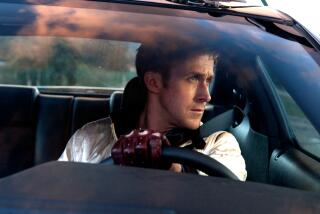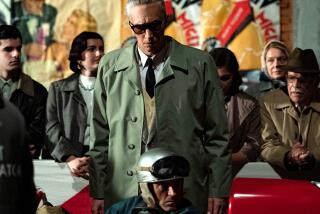‘Public Enemies’
- Share via
It takes a lot to jolt a 21st century moviegoer into a new way of seeing -- which is reason enough to applaud Michael Mann’s strange, imperfect “Public Enemies,” a period piece disorientingly told in the cinematic present tense.
Mann’s account of the brief, blazing career of the Depression-era bank robber and folk hero John Dillinger draws on a doorstop of a book (of the same title) by Bryan Burrough about two early-’30s developments: the celebrity-outlaw crime wave (led by Dillinger, Bonnie and Clyde, Baby Face Nelson and others) and the emergence of the FBI under J. Edgar Hoover.
But “Public Enemies,” shot in high-definition digital video that makes no attempt to simulate the textures of film, is content to leave history as a smudged backdrop. As its detractors have pointed out, the movie skimps on context, has a frustrating shapelessness and reveals little about its purported subject.
In fact Mann’s film, which arrives on DVD in standard-definition and Blu-ray editions this week, is an exercise in extreme narrative shorthand. It relies, to a degree that could be considered bold or lazy, on what we already know about Dillinger, about glamorous movie criminals, even about the films of Michael Mann.
Cat and mouse
This is the story of mirror-image antagonists: Johnny Depp’s unflappable Dillinger and Christian Bale’s driven G-man Melvin Purvis. But the cosmic symmetry is merely implied, more a holdover from other Mann movies (“Heat,” most famously) than a function of what happens in the on-screen cat-and-mouse game -- which is not a whole lot. The romance between Dillinger and coat-check girl Billie Frechette (Marion Cotillard) has a similarly perfunctory feel.
This supremely streamlined movie brushes aside the usual strategies of a prestige crime epic: There’s minimal psychology, barely any moral complexity, no discernible attempt at topical relevance. Anyone hoping to draw a parallel between past and present populist rage at failed financial institutions will have to look awfully hard.
The elusive Dillinger’s trademark introduction -- “I’m John Dillinger. I rob banks” -- sets the tone, as does his matter-of-fact come-on when seducing Billie: “I like baseball, movies, good clothes, fast cars, whiskey and you. What else you need to know?” And that’s precisely the point: We don’t really need to know anything more in a film that’s about iconography above all else.
“Public Enemies” gets considerable mileage from the recurring image of Depp-as-Dillinger in a dark suit and fedora, tommy gun in hand. Mann at times seems to be testing just how much emotional meaning he can generate from minimal information.
The superb opening sequence -- a jailbreak beneath an endless blue sky -- builds to a scene in which Dillinger, leaning out of his getaway car, clutches the arm of a nameless wounded associate, holding on until the man expires and falls away.
It’s a moment of startling immediacy and intensity, involving characters who are essentially unknown to us.
A mood piece
“Public Enemies” is by turns ephemeral and indelible. Much of it seems to evaporate on contact, and yet its piercing images and dreamlike flow are hard to shake. Just as Terrence Malick turns everything he touches into a transcendental reverie, Mann, on the evidence of this and the languid “Miami Vice” (2006), seems increasingly compelled to turn his so-called action movies into faintly zonked-out mood pieces.
There’s a fascinating tension throughout between the murk of the storytelling and the etched clarity of the visuals. Most Hollywood filmmakers use state-of-the-art digital to evoke celluloid, but Mann, more than any other director of his stature, has been prompted by the looming extinction of film to rethink cinematic aesthetics.
He has described the look of “Public Enemies” as hyper real, which, in this case at least, means at once more and less real. The crystalline digital image, which gets so close and so detailed you can sometimes see the actors’ pores, intensifies the sense of realism.
But at the same time, there’s nothing documentary-like about this highly stylized movie, and the video images can seem utterly unnatural, weirdly harsh and heightened.
This push-pull between reality and illusion makes sense for a movie that is, in the end, about a man and his myth: In the hall-of-mirrors climax, Dillinger sits in a Chicago theater, looking up at a movie thug played by Clark Gable. Mann doesn’t exactly rewrite the old outlaw legend of countless pulp fictions, but he does something almost as radical: He makes it both more present and less familiar.
More to Read
Only good movies
Get the Indie Focus newsletter, Mark Olsen's weekly guide to the world of cinema.
You may occasionally receive promotional content from the Los Angeles Times.








